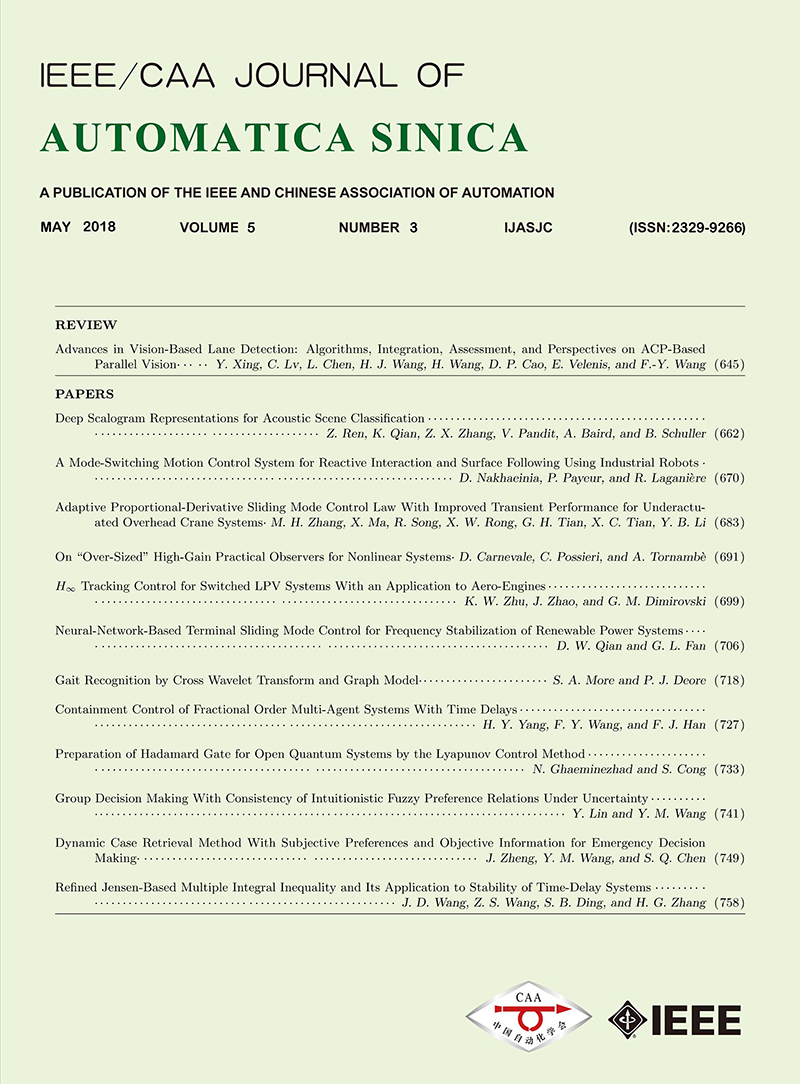 Volume 3
Issue 2
Volume 3
Issue 2
IEEE/CAA Journal of Automatica Sinica
| Citation: | Runmei Li, Chaoyang Jiang, Fenghua Zhu and Xiaolong Chen, "Traffic Flow Data Forecasting Based on Interval Type-2 Fuzzy Sets Theory," IEEE/CAA J. of Autom. Sinica, vol. 3, no. 2, pp. 141-148, 2016. |

| [1] |
Zhang J P, Wang F Y, Wang K F, Lin W H, Xu X, Chen C. Datadriven intelligent transportation systems: a survey. IEEE Transactions on Intelligent Transportation Systems, 2011, 12(4): 1624-1639
|
| [2] |
Jagadeesh G R, Dhinesh G R, Srikanthan T. Method for accuracy assessment of aggregated freeway traffic data. IET Intelligent Transport Systems, 2014, 8(4): 407-414
|
| [3] |
Zhu W, Wang F Y. On three types of covering-based rough sets. IEEE Transactions on Knowledge and Data Engineering, 2007, 19(8): 1131- 1144
|
| [4] |
Zhu W, Wang F Y. The fourth type of covering-based rough sets. Information Sciences, 2012, 201: 80-92
|
| [5] |
Stutz C, Runkler T. Classification and prediction of road trafficc using application-specific fuzzy clustering. IEEE Transactions on Fuzzy Systems, 2002, 10(3): 297-308
|
| [6] |
Williams B. Multivariate vehicular traffic flow prediction: evaluation of ARIMAX modeling. Transportation Research Record: Journal of the Transportation Research Board, 2001, 1776: 194-200
|
| [7] |
Thomas T, Weijermars W, van Berkum E. Predictions of urban volumes in single time series. IEEE Transactions on Intelligent Transport Systems, 2010, 11(1): 71-80
|
| [8] |
Hou Y, Edara P, Sun C. Traffic flow forecasting for urban work zones. IEEE Transactions on Intelligent Transportation Systems, 2015, 16(4): 1761-1770
|
| [9] |
Zadeh L A. The concept of a linguistic variable and its application to approximate reasoning-II. Information Sciences, 1975, 8(4): 301-357
|
| [10] |
Li C D, Zhang G Q, Wang H D, Ren W N. Properties and data-driven design of perceptual reasoning method based linguistic dynamic systems. Acta Automatica Sinica, 2014, 40(10): 2221-2232
|
| [11] |
Mendel J M, Hagras H, John R I. Guest editorial for the special issue on type-2 fuzzy sets and systems. IEEE Transactions on Fuzzy Systems, 2013, 21(3): 397-398
|
| [12] |
Mo H, Wang J, Li X, Wu Z L. Linguistic dynamic modeling and analysis of psychological health state using interval type-2 fuzzy sets. IEEE/CAA Journal of Automatica Sinica, 2015, 2(4): 366-373
|
| [13] |
Mo Hong, Wang Tao. Computing with words in generalized interval type-2 fuzzy sets. Acta Automatica Sinica, 2012, 38(5): 707-715 (in Chinese)
|
| [14] |
Mo H, Wang F Y. Linguistic dynamic systems based on computing with words and their stabilities. Science in China Series F: Information Sciences, 2009, 52(5): 780-796
|
| [15] |
Liu F, Mendel J M. Encoding words into interval type-2 fuzzy sets using an interval approach. IEEE Transactions on Fuzzy Systems, 2008, 16(6): 1503-1521
|
| [16] |
Mendel J M. Computing with words and its relationships with fuzzistics. Information Sciences, 2007, 177(4): 988-1006
|
| [17] |
Dehay D, Leskow J, Napolitano A. Central limit theorem in the functional approach. IEEE Transactions on Signal Processing, 2013, 61(16): 4025-4037
|